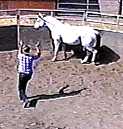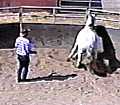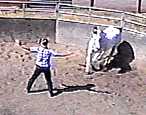Round Corral Logic
| ||||||||
| POSTURE DEFINITIONS |
While being aggressive, I'm always aware of my own safety and give myself an out in the event the horse refuses to yield and charges in on me (which has yet to happen if I have a rope or flag with me). I can do this by making a bullfighter's move; rolling off center as the horse passes by making sure to be clear of a side kick which may accompany the charge. If the horse does yield (which he generally will unless you have incited him into a flight-or-fight panic), then it's important to drop immediately from aggressive or active mode the instant he yields. You don't want to turn the "fight" into a blind "flight" either. Just get the tempo back down to what both of you can tolerate.
The Draw: The draw is a gesture or movement which increases the space between you and the horse; sort of creates an energy vacuum if you will. Since horses naturally learn on the "release" (that's how horse herd learning works), the way we tell the horse he's done something correctly is to release pressure the instant he makes progress such as making a good attempt in a difficult task or performing the correct move. We can say "good boy" until we're blue in the face, but it's that little release that really sends the "good boy" message.Now that we have the postures down, let's go back to the round corral.
| YIELDS AND DRAWS |
Yields and draws have very different implications in horse training. If I need to assert myself as the dominant animal, I'm going to cause the horse to yield. The better he yields, the more established I am as the leader; at least he respects my space and energy at this point.
The draw allows the horse to "hook up" with the handler in a more positive way. It allows him to demonstrate that he wants to be a willing partner in the relationship and to show how well he is listening and following. The draw is a significant opportunity to get feedback from your horse as to how well you are progressing. It also reassures the horse that he's not going to be chased forever and that you are actually listening to his expressions. He may also be reassured because you've given him the opportunity to "speak."
In this photo I am setting up the yield by stepping ahead of the drive line while the horse is moving and directing some energy toward him, shutting him down. At this point, since I want a reverse of direction, my right hand becomes my control hand and my left hand is my active hand. (If you are using a rope, flag or longe whip, you'd simply change hands with the tool.)
| If I step in front of the drive line, am active with my forward hand and draw slightly with my following hand, I can redirect the horse into the opening I created by the draw and he will roll toward me to complete his reverse. This maneuver takes a little practice to perfect because directing too little energy forward of the drive line will not stop the horse, but too much will cause the horse to roll away towards the wall. Also, as soon as the horse responds to the active hand (the left hand in his example) he has to pick up on the opening you are suggesting to him with the draw, so you have to think this through ahead of time in order to get your timing down. In the beginning, you can enhance the draw by taking a step backwards as soon as the horse starts to decelerate his forward motion. |
|
| In this illustration I am backing up slightly to enhance the draw. Once the horse faces me, I am going to direct his momentum into a clockwise circle along the fence with my right hand and as soon as his drive line passes me I will support his forward motion and increase his speed, if desired, with my left hand which will now become my active hand. |
|
Continue to Part threeReturn to Part OneImportant Note: If you take on the project of developing an untrained horse, everybody will want to give you advice. Don't act on any advice, including the ideas offered in this site, unless it makes sense to you and fits your individual situation. Your abilities and the sensitivities of your horse(s) may differ from the examples given. Be alert and rational with your actions so neither you nor your horse will get hurt. This information is offered as illustrations of what we do and the reader must apply common sense since he or she is solely responsible for his or her actions. Happy trails!Press "Back" to return to the page that brought you hereGo to Case Study SectionReturn to Training SectionReturn to Wild Horse MentorsReturn to KBR World of Wild Horses and BurrosGo To
| |




